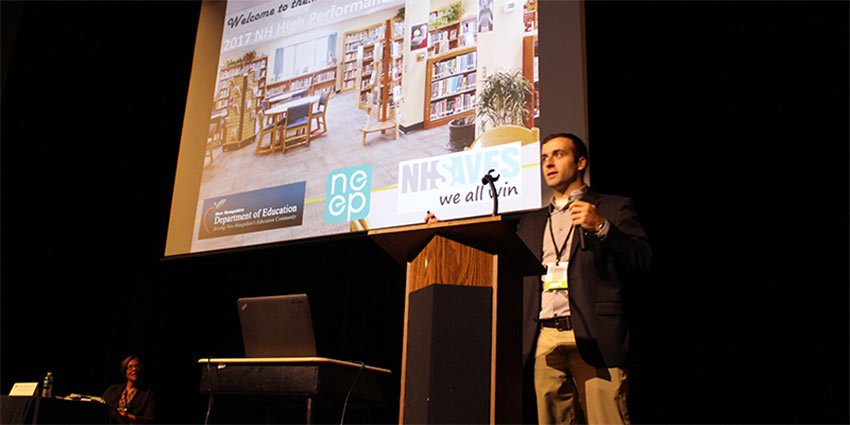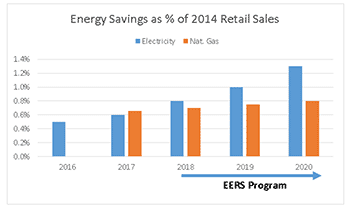By Shannon Dracup | Wed, October 25, 17
Every year, without fail, when late September rolls around, I’m fascinated by the vibrant red and gold colors that paint the trees. As a life-long New Yorker, my transition to life in New England has been made easier by the familiar natural beauty that captivates us during the fall season. Luckily, I got to experience New England’s fall foliage at its peak in Meredith, New Hampshire for NEEP’s annual High Performance Schools Summit. The sun was shining down on Inter-Lakes High School, where regional stakeholders spent the day discussing the importance of healthy learning environments and munching on cider donuts. I found myself in the donut line several times. It was a great day.
Throughout the summit, we heard from speakers who shared past projects and accomplishments that highlighted energy benchmarking, new technologies for schools, as well as helpful resources and tools to move high performance school projects forward. During one of the morning sessions, Professor Clay Mitchell from the University of New Hampshire spoke about the state’s emerging technology and financing opportunities, specifically utility programs and available incentives. His talk made me think about how the development of more high performance school projects can help New Hampshire achieve its recently adopted Energy Efficiency Resource Standard (EERS).

The New Hampshire EERS
In August 2016, the New Hampshire Public Utility Commission (PUC) issued a long-awaited order establishing an EERS, which is a policy that sets specific targets or goals for energy savings. Utility companies serving New Hampshire ratepayers must meet these goals through customer energy efficiency programs. The American Council for an Energy Efficient Economy (ACEEE) considers an EERS a key component of states’ commitment to energy efficiency. The joint utilities of New Hampshire collectively support the EERS and will serve as administrators of the programs.
The New Hampshire EERS includes long- and short-term energy savings goals throughout an initial three-year period from 2018 through 2020. It calls for a cumulative reduction in energy use of 3.1 percent compared to 2014 statewide regulated electricity sales and 2.25 percent of 2014 statewide natural gas sales by the end of 2020.

As part of the standard, utilities have agreed to reduced utility performance incentives paired with a lost-revenue adjustment mechanism (LRAM) and commitment to decoupling for each utility upon filing of its next rate case. In mid-October, an order from the PUC specified that the entire $20 million of funding directed to clean energy in Northern Pass’s (a subsidiary of the utility company Eversource) application for public utility treatment will go towards energy efficiency.
Earlier in 2017, The Energy Efficiency & Sustainable Energy Board (EESE) convened a series of workshops to examine details related to the EERS. The board was created by the NH legislature “to promote and coordinate energy efficiency, demand response, and sustainable energy programs in the state.” NEEP provided technical assistance to New Hampshire and developed a report examining non-energy impacts (NEIs) in cost-effectiveness testing to help the state establish its own protocol. The EERS will officially come into effect on January 1, 2018.
How High Performance Schools Can Help
High performing schools not only produce increased health benefits and productivity for students and staff, but they also lead to substantial energy savings. Leveraging the development of high performing schools across the state represents a great opportunity for New Hampshire to move forward in achieving its energy savings targets. This year has been a transition year with savings targets staying relatively stable while the state establishes a supporting cost-effectiveness framework.
New Hampshire is in a great position to push forward high performance school projects, especially by taking advantage of the many available state-wide programs and incentives. Local utilities and energy service companies (ESCOs) are working to offer programs that can be used to leverage these projects. NHSaves, a collaboration of New Hampshire’s four utilities and the NH Public Utilities Commission, helps communities and school districts save energy and money through audits, incentives, and technical assistance to allow municipalities to reallocate vital funds for other important needs.
It Takes a Village
NHSaves provides incentives, rebates, and services for both “low hanging fruit” fixes – such as LEDs, controls, and thermostats – as well as more capital-intensive upgrades, including HVAC equipment and chillers. Municipal customers are eligible to receive the suite of incentives available to small and large commercial customers, as well as some municipal-specific incentives. One example is the NH Energy Efficient Schools Initiative that aims to cover 100 percent of the incremental cost for key components of efficiency investments in new construction projects.
Additionally, New Hampshire’s Community Development Finance Authority (CDFA) Clean Energy Fund finances clean energy projects for schools throughout the state. Power purchase agreements (PPAs) are contracts between a provider and a buyer that are used to finance and implement renewable energy installations. This public-private partnership is an attractive opportunity for schools to work with utilities and developers to introduce reliable, lower cost energy without the large upfront costs.
NEEP’s Regional Operations and Maintenance (O&M) Guide outlines strategies for creating green, healthy, and energy efficient existing schools or public buildings. The guide contains O&M procedures that will help buildings reduce operating costs, as well as lead to healthier indoor air, improved student and staff comfort, reduced water consumption, and overall improvements in the learning environment. O&M procedures targeted at energy efficiency can lead to energy savings of up to hundreds of thousands dollars annually, and many can be achieved at little to no cost. The guide includes facts, figures, and calculators to help make the case for improving the efficiency of a school, providing a great starting point for schools to determine where to begin and how to navigate the many options in creating a high performing school.
Let every back-to-school season remind us not only of how beautiful our world can be (and how delicious maple cider donuts always are), but also the importance of continuing to foster healthy learning environments. Together we can provide our students with the best educational experience possible.
